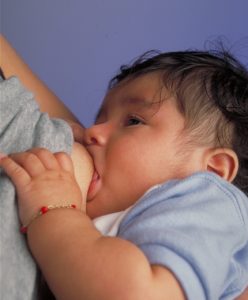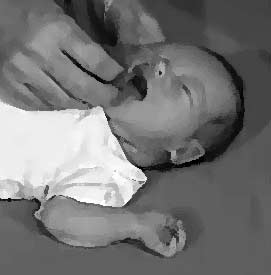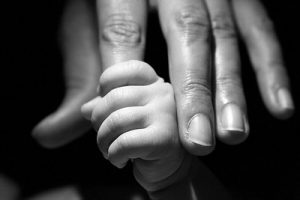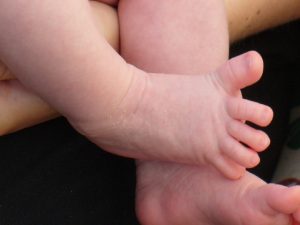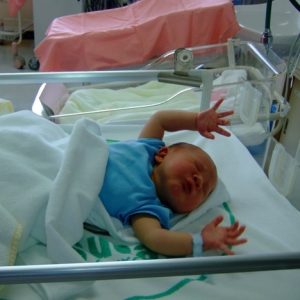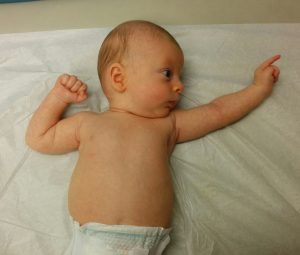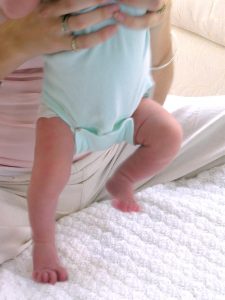Attachment
Learning Objectives: Attachment during Infancy
- Use Erikson’s theory to characterize psychosocial development during infancy.
- Describe Bowlby ethological theory of attachment.
- Describe Ainsworth's theory of attachment styles, and contrast four styles assessed using the Strange Situation Technique.
- Explain the factors that influence attachment.
- Explain how the effects of attachment can be carried forward by children's internal working models.
Developmental Task of Infancy: Trust vs. Mistrust
As discussed in Chapter 1, Erik Erikson formulated a theory of psychosocial development that posited that development is organized around eight age-graded developmental tasks. At each age, infants, children, adolescents, and adults, negotiate target developmental tasks that are specific to that period of development. When the target task is negotiated successfully, it creates a foundation for future healthy development and provides a basis for the successful negotiation of future developmental tasks. When a task is not well resolved, this makes continued healthy development more difficult.
The developmental task of infancy is trust vs. mistrust, and it is negotiated in the establishment of a secure attachment relationship with the caregiver. Erikson maintained that during the first year to year and a half of life the most important goal is the development of a basic sense of trust in one’s caregivers (Erikson, 1982). Infants are dependent and must rely on others to meet their basic physical and psychological needs. A caregiver who consistently meets these needs instills a sense of trust or the belief that the world is a trustworthy place. Caregivers should not worry about overly indulging an infant's need for comfort, contact, or stimulation. Caregiver responsiveness communicates to infants that their needs will be taken care of, and so is essential in supporting the development of a sense of trust.
Problems establishing trust: Erikson (1982) believed that basic mistrust could interfere with many aspects of psychosocial development and make it more difficult to build love and fellowship with others. Consider the implications for establishing trust if a caregiver is unavailable or is upset and ill-prepared to care for a child. Or if a child is born prematurely, is unwanted, or has physical problems that make him or her less attractive to a parent. Under these circumstances, we cannot assume that the parent is going to care for the child in ways that support the development of trust. As you will read later, it is possible to rework mental models of insecure early relationships, but close and caring relationships with primary caregivers make it much easier for infants to negotiate this first developmental task.
What Babies Come With
Newborns are equipped with a number of reflexes which are involuntary movements in response to stimulation (see Table 3.2). Some of the more common reflexes, such as the sucking reflex and rooting reflex, are important to feeding. The grasping and stepping reflexes are eventually replaced by more voluntary behaviors. Within the first few months of life these reflexes disappear, while other reflexes, such as the eye-blink, swallowing, sneezing, gagging, and withdrawal reflex stay with us as they continue to serve important functions. Reflexes offer pediatricians insight into the maturation and health of the nervous system. In preterm infants and those with neurological impairments, some of these reflexes may be absent at birth. Once present, they may persist longer than in a neurologically healthy infant (El-Dib, Massaro, Glass & Aly, 2012). Reflexes that persist longer than they should can impede normal development (Berne, 2006).
Table 3.2 Some Common Infant Reflexes
adapted from Lally & Valentine-French, 2019
Forming Attachments

Attachment is a strong affectionate bond that binds an infant to a specific intimate caregiver, and from which the infant derives a sense of security. The formation of attachments in infancy has been the subject of considerable research since attachments are viewed as foundations for future relationships. Additionally, attachments form the basis for confidence and curiosity as toddlers, and are important influences on self-concept.
Freud’s Psychoanalytic Theory. According to Freud (1938) infants are oral creatures who obtain pleasure from sucking and mouthing objects. Freud believed the infant will become attached to a person or object that provides this pleasure. Consequently, infants were believed to become attached to their mother because she was the one who satisfied their oral needs and provided pleasure. Freud further believed that infants will become attached to their mothers “if the mother is relaxed and generous in her feeding practices, thereby allowing the child a lot of oral pleasure,” (Shaffer, 1985, p. 435). Was Freud correct in his explanation for why infants became attached?
Harlow’s Research. In a classic study testing whether feeding was the most important factor in attachment, Wisconsin University psychologists Harry and Margaret Harlow investigated the responses of young monkeys. Infant monkeys were separated from their biological mothers, and two surrogate mothers were introduced into their cages. One, the wire mother, consisted of a round wooden head, a mesh of cold metal wires, and a bottle of milk from which the baby monkey could drink. The second mother was a foam-rubber form wrapped in a heated terry-cloth blanket. The infant monkeys went to the wire mother for food, but they overwhelmingly preferred and spent significantly more time with the warm terry-cloth mother. The warm terry-cloth mother provided no food but did provide comfort (Harlow, 1958). The infant's need for physical closeness and touching is referred to as contact comfort. Contact comfort is believed to be the foundation for attachment. The Harlows’ studies confirmed that babies have social as well as physical needs. Both monkeys and human babies need a secure base that allows them to feel safe. From this base, they can gain the confidence they need to venture out and explore their worlds.
Bowlby’s Theory. Building on the work of ethologists (who study animal behavior under natural conditions), John Bowlby developed a theory of attachment. He defined attachment as the affectional bond or tie that an infant forms with the caregiver (Bowlby, 1969). This bond provides a basis for normal neurophysiological, social, and emotional development. In addition, Bowlby proposed that this attachment bond is very powerful and continues throughout life. He used the concept of a secure base to define a healthy attachment between parent and child (Bowlby, 1982). A secure base is a parental presence that gives the child a sense of safety as the child explores the surroundings.
Bowlby said that two things are needed for a healthy attachment: The caregiver must be responsive to the child’s physical, social, and emotional needs; and the caregiver and child must engage in mutually enjoyable interactions (Bowlby, 1969). Additionally, Bowlby observed that infants would go to extraordinary lengths to prevent separation from their parents, such as crying, refusing to be comforted, and waiting for the caregiver to return. He observed that these same expressions were common to many other mammals, and consequently argued that these negative responses to separation serve an evolutionary function. Because mammalian infants cannot feed or protect themselves, they are dependent upon the care and protection of adults for survival. Thus, those infants who were able to maintain proximity to an attachment figure were more likely to survive and reproduce.
Four Stages of Attachment
Please watch the video below for a description of the four developmental stages of attachment.
Mary Ainsworth and the Strange Situation Technique
Developmental psychologist Mary Ainsworth, a student of John Bowlby, continued studying the development of attachment in infants. Ainsworth and her colleagues created a laboratory test that measured an infant’s attachment to his or her parent. The test is called The Strange Situation Technique because it is conducted in a context that is unfamiliar to the child and therefore likely to heighten the child’s need for his or her parent (Ainsworth, 1979).
During the procedure, that lasts about 20 minutes, the parent and the infant are first left alone, while the infant explores the room full of toys. Then a strange adult enters the room and talks for a minute to the parent, after which the parent leaves the room. The stranger stays with the infant for a few minutes, and then the parent again enters, and the stranger leaves the room. During the entire session, a video camera records the child’s behaviors, which are later coded by trained coders. The investigators were especially interested in how the child responded to the caregiver leaving and returning to the room, referred to as the “reunion.” On the basis of their behaviors, the children are categorized into one of four groups where each group reflects a different kind of attachment relationship with the caregiver. One style is secure and the other three styles are referred to as insecure.
- A child with a secure attachment style usually explores freely while the caregiver is present and may engage with the stranger. The child will typically play with the toys and bring one to the caregiver to show and describe from time to time. The child may be upset when the caregiver departs but is also happy to see the caregiver return.
- A child with a resistant (sometimes called ambivalent) attachment style is wary about the situation in general, particularly the stranger, and stays close or even clings to the caregiver rather than exploring the toys. When the caregiver leaves, the child is extremely distressed and is ambivalent when the caregiver returns. The child may rush to the caregiver, but then fails to be comforted when picked up. The child may still be angry and even resist attempts to be soothed.
- A child with an avoidant attachment style will avoid or ignore the mother, showing little emotion when the mother departs or returns. The child may run away from the mother when she approaches. The child will not explore very much, regardless of who is there, and the stranger will not be treated much differently from the mother.
- A child with a disorganized/disoriented attachment style seems to have an inconsistent way of coping with the stress of the strange situation. The child may cry during the separation, but avoid the mother when she returns, or the child may approach the mother but then freeze or fall to the floor.
Table 3.3 Strange Situation
| Stages | Event | Secure | Insecure-Avoidant | Insecure-Resistant | Insecure-Disorganized |
|---|---|---|---|---|---|
| 1 | Exploration with caregiver in room | Explores freely | High exploration, but unfocused | Stays close to caregiver | Chaotic exploration |
| 2 | Stranger enters room and talks with caregiver | May interact with stranger | Indifferent to stranger | Afraid of stranger when caregiver present | Afraid or uncertain about stranger |
| 3 | Caregiver leaves room and child is left alone with stranger | May be upset when caregiver leaves | Not upset when caregiver leaves | High distress when alone with stranger | Unpredictable (may be upset or not) |
| 4 | Reunion with caregiver | Happy to see caregiver return | Ignores or avoids caregiver | Ambivalent: wants contact with caregiver but is upset at them | Reacts to return of caregiver with distress |
How common are the attachment styles among children in the United States? It is estimated that about 65 percent of children in the United States are securely attached. Twenty percent exhibit avoidant styles and 10 to 15 percent are ambivalent. Another 5 to 10 percent may be characterized as disorganized (Ainsworth, Blehar, Waters, & Wall, 1978).

Some cultural differences in attachment styles have been found (Rothbaum, Weisz, Pott, Miyake, & Morelli, 2000). For example, German parents value independence and Japanese mothers are typically by their children’s sides. As a result, the rate of insecure-avoidant attachments is higher in Germany and insecure-resistant attachments are higher in Japan. These differences reflect cultural variation rather than true insecurity, however (van Ijzendoorn and Sagi, 1999). Overall, secure attachment is the most common type of attachment seen in every culture studied thus far (Thompson, 2006).
Caregiver Interactions and the Formation of Attachment
Most developmental psychologists argue that a child becomes securely attached when there is consistent contact from one or more caregivers who meet the physical and emotional needs of the child in a responsive and appropriate manner. However, even in cultures where mothers do not talk, cuddle, and play with their infants, secure attachments can develop (LeVine et. al., 1994).
The insecure resistant (or ambivalent) style occurs when the parent is insensitive and responds inconsistently to the child’s needs. Consequently, the infant is never sure that the world is a trustworthy place or that he or she can rely on others without some anxiety. A caregiver who is unavailable, perhaps because of marital tension, substance abuse, or preoccupation with work, may send a message to the infant he or she cannot rely on having needs met. An infant who receives only sporadic attention when experiencing discomfort may not learn how to calm down. The child may cry if separated from the caregiver and also cry upon their return. They seek constant reassurance that never seems to satisfy their doubt. Keep in mind that clingy behavior can also just be part of a child’s natural disposition or temperament and does not necessarily reflect some kind of parental neglect. Additionally, a caregiver that attends to a child’s frustration can help teach them to be calm and to relax.
The insecure avoidant style is marked by insecurity, but this style is also characterized by a tendency to avoid contact with the caregiver and with others. This child may have learned that needs typically go unmet and learns that the caregiver does not provide care and cannot be relied upon for comfort, even sporadically. An insecure avoidant child learns to be more independent and disengaged.
The insecure disorganized/disoriented style represents the most insecure style of attachment and occurs when the child is given mixed, confused, and inappropriate responses from the caregiver. For example, a mother who suffers from schizophrenia may laugh when a child is hurting or cry when a child exhibits joy. The child does not learn how to interpret emotions or to connect with the unpredictable caregiver. This type of attachment is also often seen in children who have been abused. Research has shown that abuse disrupts a child’s ability to regulate their emotions (Main & Solomon, 1990).
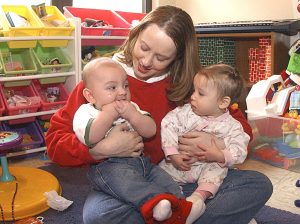
Support for caregivers. Sometimes parents need help in responding consistently to their infant's needs. A positive and strong support group can help a parent and child build a strong foundation by offering assistance and positive attitudes toward the newborn and parent. In a direct test of this idea, Dutch researcher van den Boom (1994) randomly assigned some babies’ mothers to a training session in which they learned to better respond to their children’s needs. The research found that these mothers’ babies were more likely to show a secure attachment style in comparison to the mothers in a control group that did not receive training.
Social Deprivation. Severe deprivation of parental attachment can lead to serious problems. Infants who, perhaps because of being in orphanages with inadequate care, have not had the opportunity to attach in infancy may still form initial secure attachments several years later. However, they may have more emotional problems of depression, anger, or be overly friendly as they interact with others (O’Connor et. al., 2003). According to studies of children who have not been given warm, nurturing care, they may show developmental delays, failure to thrive, and attachment disorders (Bowlby, 1982). Non-organic failure to thrive is the diagnosis for an infant who does not grow, develop, or gain weight on schedule and there is no known medical explanation for this failure. Poverty, neglect, inconsistent parenting, and severe family dysfunction are correlated with non-organic failure to thrive. In addition, postpartum depression can cause even a well-intentioned mother to neglect her infant.
Reactive Attachment Disorder: Children who experience social neglect or deprivation, repeatedly change primary caregivers that limit opportunities to form stable attachments or are reared in unusual settings (such as institutions) that limit opportunities to form stable attachments can certainly have difficulty forming attachments. According to the Diagnostic and Statistical Manual of Mental Disorders, 5th edition (American Psychiatric Association, 2013), those children experiencing neglectful situations and also displaying markedly disturbed and developmentally inappropriate attachment behavior, such as being inhibited and withdrawn, minimal social and emotional responsiveness to others, and limited positive affect, may be diagnosed with reactive attachment disorder. This disorder often occurs with developmental delays, especially in cognitive and language areas. Fortunately, the majority of severely neglected children do not develop reactive attachment disorder, which occurs in less than 10% of such children. The quality of the caregiving environment after serious neglect affects the development of this disorder.
Internal Working Models of Attachment
As research accumulated showing the long-term effects of the quality of attachment between young children and their caregivers, researchers became very interested in the question of why -- as in “Why does attachment at an early age predict later aspects of social, emotional, and cognitive development?” To answer this question, they began exploring possible mediating mechanisms, looking for the pathways through which attachment exerts its effects. Research has uncovered several mechanisms, including neurophysiological pathways (e.g., children in securely attached dyads have lower levels of stress reactivity), but among the most interesting are young children’s (and the later older children’s, adolescents’, and adults’) internal working models of close relationships (Crittenden, 1999; Dykas & Cassidy, 2011; Main, Kaplan, & Cassidy, 1985).
As attachment develops, day-to-day interactions between infant and caregiver form the basis of the infant’s internal working model – a set of beliefs and expectations they build about the availability and reliability of their attachment figures (Sherman, Rice, & Cassidy, 2015). These internal working models are constructed starting at a very young age, about the age of four months, as soon as children have the capacity to mentally represent their experiences. It is as if over the first few years of life infants are “taking mental notes” about how these important relationships function, and the effects of these expectations can be seen in the ways infants wait after sending out distress signals to see if their caregiver is on the way or they need to escalate their communications. The specific, repeated experiences babies have with their caregivers become more generalized and internalized over time, indicating whether the attachment figure can be counted on for dependable comfort and protection in times of distress, and so can serve as a secure base from which the infant can explore the world. This inner representation then informs what types of behavior can be expected from others, i.e., whether a person will pick them up when they are upset or should be turned to for comfort when they are sad.
As children start to interact and form relationships with others, like other family members, preschool teachers, and peers, their internal working models forms the basis of their expectations for how people will respond to them, and therefore shape their own behavior in relationships. Negative experiences with one caregiver may, for example, create the expectation that people are not to be trusted, and so young children are less able to be their authentic selves, or reach out to others when they are upset and need comfort. Because these internal working models influence children’s behavior, they may shape the quality of their subsequent relationships, all the way up until adolescence and young adulthood (Allen & Miga, 2010). For example, adolescents with insecure-resistant internal working models may show ambivalence about close romantic relationships, both intensely wanting them but also being resentful about the extent to which their needs are being met (Mikulincer, Shaver, Bar-On, & Ein-Dor, 2010).
Though these inner representations tend to stay somewhat stable for children with secure attachments, they can continue to grow and change as children age and gather more social experiences. For example, consistent, warm, and caring interactions with other attachment figures, such as grandmothers or preschool teachers, have the power to change those beliefs allowing children to rework a negative internal working model into a positive one. Internal working models can be reworked at any age, as children encounter family members, neighbors, teachers or other adults who provide high quality care. For adolescents, close and caring friendships can provide opportunities to reconsider and expand their understanding of relationships. The good news is that, as adults, we can become aware of our own internal working models of relationships and see how we may be bringing things from previous relationships into subsequent ones, in ways that are causing us problems. Then we can intentionally rework our expectations about others in ways that make it easier for us to form secure relationships with our friends, romantic partners, and eventually our own children.
References
Ainsworth, M. (1979). Infant-mother attachment. American Psychologist, 34(10), 932-937.
Ainsworth, M., Blehar, M., Waters, E., & Wall, S. (1978). Patterns of attachment. Hillsdale, NJ: Erlbaum.
Akimoto, S. A., & Sanbinmatsu, D. M. (1999). Differences in self-effacing behavior between European and Japanese Americans: Effect on competence evaluations. Journal of Cross-Cultural Psychology, 30, 159-177.
Allen, J. P. & Miga, E. M. (2010). Attachment in adolescence: A move to the level of emotion regulation. Journal of Social and Personal Relationships, 27, 181-190. doi:10.1177/0265407509360898
American Psychiatric Association. (2013). Diagnostic and statistical manual of mental disorders, 5th edition (DSM-5). Washington, DC: Author.
Berk, L. E. (2007). Development through the life span (4th ed.). Boston: Allyn and Bacon.
Berne, S. A. (2006). The primitive reflexes: Considerations in the infant. Optometry & Vision Development, 37(3), 139-145.
Bowlby, J. (1969). Attachment and loss. London: Hogarth Press.
Bowlby, J. (1982). Attachment (2nd ed.). New York: Basic Books.
Crittenden, P. M. (1999). Internal representational models of attachment relationships. Infant Mental Health Journal, 11, 259-277. doi:10.1002/1097-0355(199023)11:3<259::AID-IMHJ2280110308>3.0.CO;2-J
Dykas, M. J., & Cassidy, J. (2011). Attachment and the processing of social information across the life span: Theory and evidence. Psychological Bulletin, 137, 19-46. doi:10.1037/a0021367
Erikson, E. (1982). The life cycle completed. NY: Norton & Company.
Freud, S. (1938). An outline of psychoanalysis. London: Hogarth.
Gillath, O., Shaver, P. R., Baek, J. M., & Chun, D. S. (2008). Genetic correlates of adult attachment style. Personality & Social Psychology Bulletin, 34, 1396–1405.
Harlow, H. F. (1958). The nature of love. American Psychologist, 13, 673-685.
Main, M., Kaplan, N., & Cassidy, J. (1985). Security in infancy, childhood, and adulthood: A move to the level of representation. In I. Bretherton & E. Waters (Eds.), Growing points in attachment theory and research. Monographs of the Society for Research in Child Development, 50, 66-106. doi:10.2307/3333827
Main, M., & Solomon, J. (1990). Procedures for identifying infants as disorganized/disoriented during the Ainsworth Strange Situation. In M. T. Greenberg, D. Cicchetti, & E. M. Cummings (Eds.), Attachment in the Preschool Years (pp. 121–160). Chicago, IL: University of Chicago Press.
Mikulincer, M., Shaver, P. R., Bar-On, N., & Ein-Dor, T. (2010). The pushes and pulls of close relationships: Attachment insecurities and relational ambivalence. Journal of Personality and Social Psychology, 98,450-468. doi:10.1037/a0017366
O'Connor, T. G., Marvin, R. S., Rotter, M., Olrich, J. T., Britner, P. A., & The English and Romanian Adoptees Study Team. (2003). Child-parent attachment following early institutional deprivation. Development and Psychopathology, 15, 19-38.
Rothbaum, F., Weisz, J., Pott, M., Miyake, K., & Morelli, G. (2000). Attachment and culture: Security in the United States and Japan. American Psychologist, 55, 1093-1104.
Seifer, R., Schiller, M., Sameroff, A., Resnick, S., & Riordan, K. (1996). Attachment, maternal sensitivity, and infant temperament during the first year of life. Developmental Psychology, 32, 12-25.
Sherman, L. J., Rice, K., & Cassidy, J. (2015). Infant capacities related to building internal working models of attachment figures: A theoretical and empirical review. Developmental Review, 37, 109-141. doi:10.1016/j.dr.2015.06.001
van den Boom, D. C. (1994). The influence of temperament and mothering on attachment and exploration: An experimental manipulation of sensitive responsiveness among lower-class mothers with irritable infants. Child Development, 65, 1457–1477.
Van Ijzendoorn, M. H., & Sagi, A. (1999). Cross-cultural patterns of attachment. In J. Cassidy & P. R. Shaver (Eds.), Handbook of attachment: Theory, research, and clinical applications (pp. 713-734). New York: Guilford.
OER Attribution:
"Lifespan Development: A Psychological Perspective, Second Edition" by Martha Lally and Suzanne Valentine-French is licensed under a CC-BY-NC-SA-3.0 / additional material (Internal Working Model of Attachment; Table 3.3 Strange Situation) by Ellen Skinner & Kristen Raine, Portland State University is licensed under a CC-BY-NC-SA-4.0
Video Attribution:
How babies form attachments by Psychology Unlocked is licensed All Rights Reserved and is embedded here according to YouTube terms of service.
Media Attributions
- Breastfeeding_infant © Ken Hammond - USDA is licensed under a Public Domain license
- Rooting © Patty2 at English Wikipedia is licensed under a Public Domain license
- grasp © Raul Luna is licensed under a CC BY (Attribution) license
- Babinski-newborn © Medicus of Borg is licensed under a CC BY-SA (Attribution ShareAlike) license
- Moro_Reflex2 © tawamie is licensed under a CC BY-SA (Attribution ShareAlike) license
- Asymmetrical_tonic_neck_reflex_(ATNR)_at_Two_Months © Mjlissner is licensed under a CC0 (Creative Commons Zero) license
- newborn_stepreflex_BRAND-PH_EN
- larry-crayton-e2qz2V0SMpo-unsplash © Larry Crayton is licensed under a CC0 (Creative Commons Zero) license
- attachment is licensed under a Public Domain license
- caregiverconsistency is licensed under a Public Domain license

